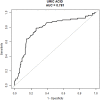Association of Serum Uric Acid Levels in Meige's Syndrome
- PMID: 34658782
- PMCID: PMC8517269
- DOI: 10.3389/fnins.2021.755056
Association of Serum Uric Acid Levels in Meige's Syndrome
Abstract
Uric acid (URIC) is a natural antioxidant, and it has been shown that low levels of URIC could be a risk factor for the development of Parkinson's disease. Our aim was to investigate whether URIC also plays a role in Meige's syndrome (MS). We conducted a cohort study to compare serum URIC levels between patients with MS and healthy controls. In addition, we analyzed the impact of URIC on the risk of MS and symptom severity. Compared with normal subjects, URIC content was remarkably decreased in MS patients. In addition, URIC was regarded as a protective factor for MS, as verified by multivariate logistic regression models. We also found non-linear relationships between the levels of serum URIC and the incidence rate of MS and the Burke-Fahn-Marsden dystonia rating scale score. Our study is the first to show a connection between serum URIC levels and MS. Low serum URIC levels indicate an increased risk of MS incidence and more severe clinical symptoms. Our findings provide new insights into the prevention and treatment of MS.
Keywords: Burke-Fahn-Marsden dystonia rating scale score; Meige’s syndrome; antioxidants; movement disorders; uric acid.
Copyright © 2021 Guan, Geng, Yuan and Chang.
Conflict of interest statement
The authors declare that the research was conducted in the absence of any commercial or financial relationships that could be construed as a potential conflict of interest.
Figures



References
LinkOut - more resources
Full Text Sources

